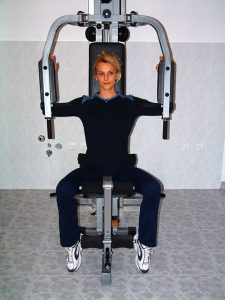In the broad sense, kinesis-therapy covers all treatment methods that are connected to movement, including manual medicine. In practice, manipulative procedures of manual medicine are treated separately. Extra confusion may be caused by the fact that even professors, i.e. teachers and kinesiologists have the right to implement and conduct active kinesis-therapy exercises. However, passive manual techniques do not belong to the domain of their practice. They belong to the domain of physical therapists and, of course, physiatrists. Our approach to passive procedures has already been described in the section on manual medicine; it is to increase or so to say retrieve the full range of movements! Here we also include optimisation (the tendency to equalise the range of movements in asymmetry). We would like to emphasise that people, in fact, are more or less asymmetric bodies, which reflects in the way that the range of movements of the left and of the right side of the body are not equal, nor is the muscle power. Preventively, until there is pain or a pathological deviation of the spine in the frontal plane, one should act in order to equalise anatomic and functional relations between the left and the right side of the body. With defined injuries or degenerative functions we first focus on the local problem, and then we correct the mobility of the joints and muscle power of the entire system. The task of kinesis-therapy is to reduce body weight. In order to do so, we dose the exercise of lower intensity and longer duration (power waking, running on a treadmill, the ecliptic machine, swimming …) with the goal of losing extra body fat.
The training equipment at the Tranfić Policlinic is adapted to people with physical suffering of the spine, joints, muscles, and they are also used as a modification of the training in the phase between rehabilitation and returning to full sports and recreational activities. We pay great attention to individually teaching our patients how to exercise properly and eat healthy. Since reducing body weight is one of the imperatives for preventing damage to the musculoskeletal system, we also advise when to use which form of recreational aerobic activity. We take care of the choice of the type of exercise most appropriate with respect to the patient’s body status. Special types of kinesis physical therapy that we prefer are the kinetic with hip surgery and knee surgery, total hip (a device working the magnetic force to regulate a 0.5 kg (1.1 lbs) load), a table for spinal balance – active and passive and FITVIBE (active vibration exercises and passive vibration). We especially determine exercise programmes for passive groups in asymmetric and other sports.


